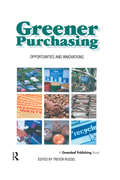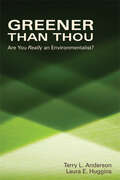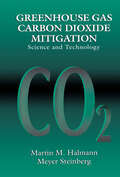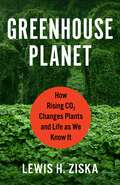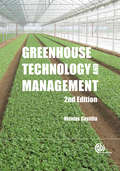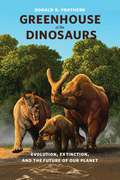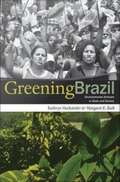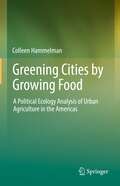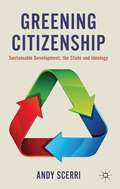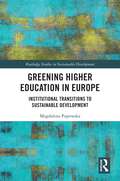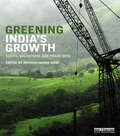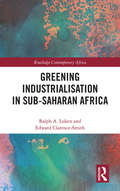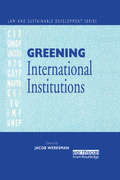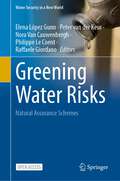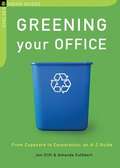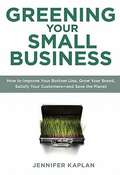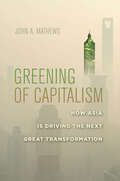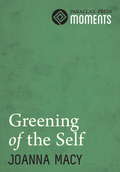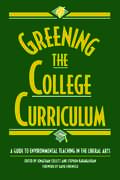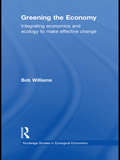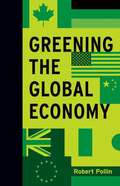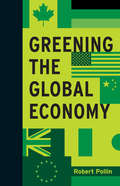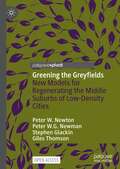- Table View
- List View
Greener Purchasing: Opportunities and Innovations
by Trevor RusselEvery organization, public and private, no matter what its size, purchases goods and services. Large organizations also have considerable influence over the practices of their suppliers. As greener purchasing practices have become more common in large organisations, the implications for companies in the supply chain have similarly increased. Yet greener purchasing policies remain the exception rather than the norm in large organizations. Why is this? And how can environmental purchasing practices that have produced tangible business benefits for a number of companies worldwide receive wider take-up? Greener Purchasing: Opportunities and Innovations has been published to facilitate the development and dissemination of best practice in environmental supply chain and procurement management worldwide. Divided into four sections, covering "The Public Sector", "The Private Sector", "Innovations" and "Case Studies", this book brings together international expertise from four continents, including contributions from organisations such as the US EPA, Environment Canada, Procter & Gamble, Xerox and The Body Shop, as well as describing burgeoning new initiatives such as the Japanese and European Green Purchasing Networks. It provides a number of checklists and examples on how to establish and maintain successful greener purchasing and supply chain practices in order to bring not only environmental, but business value to organisations of all sizes. The book is essential reading for purchasing officers, environmental managers, CEOs, consultants, academics and students interested in the topic around the world.
Greener than Thou: Are You Really An Environmentalist?
by Terry L. Anderson Laura E. HugginsIn a powerful argument for free market environmentalism, Terry Anderson and Laura Huggins break down liberal and conservative stereotypes of what it means to be an environmentalist. They show that, by forming local coalitions around market principles, stereotypes are replaced by pragmatic solutions that improve environmental quality without necessarily increasing red tape.
Greenhouse Gas Carbon Dioxide Mitigation: Science and Technology
by Martin M. Halmann Meyer SteinbergAny mention of the "greenhouse effect" tends to ignite controversy. While the rising atmospheric concentrations of greenhouse gases-especially carbon dioxide- are certainly among the most pressing issues today, theoretical and perceived consequences have been subject to conjecture and misinformation. That raging debate has obscured an important
Greenhouse Planet: How Rising CO2 Changes Plants and Life as We Know It
by Lewis H. ZiskaThe carbon dioxide that industrial civilization spews into the atmosphere has dramatic consequences for life on Earth that extend beyond climate change. CO2 levels directly affect plant growth, in turn affecting any kind of life that depends on plants—in other words, everything.Greenhouse Planet reveals the stakes of increased CO2 for plants, people, and ecosystems—from crop yields to seasonal allergies and from wildfires to biodiversity. The veteran plant biologist Lewis H. Ziska describes the importance of plants for food, medicine, and culture and explores the complex ways higher CO2 concentrations alter the systems on which humanity relies. He explains the science of how increased CO2 affects various plant species and addresses the politicization and disinformation surrounding these facts.Ziska confronts the claim that “CO2 is plant food,” a longtime conservative talking point. While not exactly false, it is deeply misleading. CO2 doesn’t just make “good” plants grow; it makes all plants grow. It makes poison ivy more poisonous, kudzu more prolific, cheatgrass more flammable. CO2 stimulates some species more than others: weeds fare particularly well and become harder to control. Many crops grow more abundantly but also become less nutritious. And the further effects of climate change will be formidable.Detailing essential science with wit and panache, Greenhouse Planet is an indispensable book for all readers interested in the ripple effects of increasing CO2.
Greenhouse Technology and Management
by Nicolas Castilla Esteban BaezaGreenhouse cultivation has expanded in recent decades with increased demand for horticultural production. This book covers current technologies and management practices of general greenhouse production, with a particular emphasis on plastic greenhouses and vegetable growing. The author begins by addressing the natural greenhouse microclimate, in the context of managing greenhouse systems such as ventilation, cooling, heating, carbon dioxide enrichment, light management, crop physiology, greenhouse design and construction criteria. The book then moves on to cover other issues of greenhouse management including irrigation and fertilization, soil and substrate cultivation, plant protection, regulation, economic analysis, environmental impact, and post-harvest, production strategies and marketing. Providing an integrated approach to greenhouse production this practical text aims to provide clear advice on optimising the yield and quality of crops grown under greenhouse conditions.
Greenhouse of the Dinosaurs: Evolution, Extinction, and the Future of Our Planet
by Prothero Donald R.What can fossils tell us about the climate change in the future?
Greenhouse of the Dinosaurs: Evolution, Extinction, and the Future of Our Planet
by Donald R. ProtheroDonald R. Prothero's science books combine leading research with first-person narratives of discovery, injecting warmth and familiarity into a profession that has much to offer nonspecialists. Bringing his trademark style and wit to an increasingly relevant subject of concern, Prothero links the climate changes that have occurred over the past 200 million years to their effects on plants and animals. In particular, he contrasts the extinctions that ended the Cretaceous period, which wiped out the dinosaurs, with those of the later Eocene and Oligocene epochs.Prothero begins with the "greenhouse of the dinosaurs," the global-warming episode that dominated the Age of Dinosaurs and the early Age of Mammals. He describes the remarkable creatures that once populated the earth and draws on his experiences collecting fossils in the Big Badlands of South Dakota to sketch their world. Prothero then discusses the growth of the first Antarctic glaciers, which marked the Eocene-Oligocene transition, and shares his own anecdotes of excavations and controversies among colleagues that have shaped our understanding of the contemporary and prehistoric world. The volume concludes with observations about Nisqually Glacier and other locations that show how global warming is happening much quicker than previously predicted, irrevocably changing the balance of the earth's thermostat. Engaging scientists and general readers alike, Greenhouse of the Dinosaurs connects events across thousands of millennia to make clear the human threat to natural climate change.
Greening Brazil: Environmental Activism In State and Society
by Margaret E. Keck Kathryn HochstetlerGreening Brazil challenges the claim that environmentalism came to Brazil from abroad. Two political scientists, Kathryn Hochstetler and Margaret E. Keck, retell the story of environmentalism in Brazil from the inside out, analyzing the extensive efforts within the country to save its natural environment, and the interplay of those efforts with transnational environmentalism. The authors trace Brazil's complex environmental politics as they have unfolded over time, from their mid-twentieth-century conservationist beginnings to the contemporary development of a distinctive socio-environmentalism meant to address ecological destruction and social injustice simultaneously. Hochstetler and Keck argue that explanations of Brazilian environmentalism--and environmentalism in the global South generally--must take into account the way that domestic political processes shape environmental reform efforts. The authors present a multilevel analysis encompassing institutions and individuals within the government--at national, state, and local levels--as well as the activists, interest groups, and nongovernmental organizations that operate outside formal political channels. They emphasize the importance of networks linking committed actors in the government bureaucracy with activists in civil society. Portraying a gradual process marked by periods of rapid advance, Hochstetler and Keck show how political opportunities have arisen from major political transformations such as the transition to democracy and from critical events, including the well-publicized murders of environmental activists in 1988 and 2004. Rather than view foreign governments and organizations as the instigators of environmental policy change in Brazil, the authors point to their importance at key moments as sources of leverage and support.
Greening Cities by Growing Food: A Political Ecology Analysis of Urban Agriculture in the Americas
by Colleen HammelmanThis book examines how urban agriculture (UA) is valued in the sustainable city. Through a comparative examination of UA projects in four cities across the Americas – Rosario, Argentina; Toronto, Canada; Medellín, Colombia; and Charlotte, USA – the book illustrates local manifestations of the socio-ecological dimensions of the global food system, and traces theoretical and empirical explanations for the impact of global political economic structures (sustainable neoliberalism) on local efforts to promote social and environmental goals through UA. The study contributes to literature on UA, sustainability, and urban geography through examining the ability of marginalized communities to compete for land on which to grow produce in contribution to their food security, livelihoods, communities, and environments, and will be of interest to UA practitioners, students, and scholars of geography, sociology, sustainability studies, environmental studies, and food studies.This project is distinctive for its global - local orientation that uses local cases to shed light on global phenomena relating to sustainability, neoliberalism, and policy mobilities. It is also important for its qualitative approach to understanding the perceived value of UA. Throughout the research, stakeholders emphasized the qualitative values of UA (such as social integration for new immigrants) that are not easily captured in statistical representations of the economic value of a given piece of urban land. As such, this book seeks to contribute to understanding about the contributions UA makes to a city beyond the food produced, and fill gaps in literature regarding the local manifestations of global policy in UA projects seeking to address both sustainability and social justice objectives.
Greening Citizenship
by Andy ScerriThe greening of citizenship, the state and ideology has created both opportunities and bottlenecks for progressive political movements. Scerri argues that these are pursuing justice by making holistic demands for: fair distribution and status recognition, adequate representation and effective participation.
Greening Higher Education in Europe: Institutional Transitions to Sustainable Development (Routledge Studies in Sustainable Development)
by Magdalena PopowskaThis book provides a comprehensive overview of the advances that have taken place in European higher education institutions (HEIs) over the last 20 years in response to the challenges of sustainable development.In recent years, there has been a visible shift toward sustainable development, and universities have been addressing their accountability to the public through corporate social responsibility. Greening Higher Education in Europe explores these recent developments, beginning with an introduction to sustainable development and its complexity, followed by a discussion of the regulatory and organizational context of higher education in Europe. This book goes on to examine the key pillars of sustainable development in HEIs, including education, research, and campus development, demonstrating best practices from a range of European universities including the University of Groningen (The Netherlands), Lund University (Sweden), Aalto University (Finland), and The University of Edinburgh (UK), among others. It also explores the role of HEIs in educating future leaders in sustainable development and presents a framework for understanding the values and decision-making processes of HEI leaders. It concludes by highlighting the need for a new paradigm in HEIs that promotes innovation, quality, equity, and respect for the environment.This book will be useful for scholars and academic professionals from a wide variety of disciplines, including sustainability, especially in its educational, research, and practical (applied) dimensions. It will also be a useful resource for postgraduate students in management and engineering.
Greening India's Growth: Costs, Valuations and Trade-offs
by Muthukumara S. ManiIndia’s sustained and rapid economic growth offers an opportunity to lift millions out of poverty. But this may come at a steep cost to its environment and natural resources. This insightful book analyses India’s growth from an economic perspective and assesses whether India can grow in a "green" and sustainable manner. Three key issues are addressed. The first is the physical and monetary costs and losses of environmental health and natural resources driven by economic growth. The authors undertake a monetary valuation and quantification of environmental damage, using techniques that have been developed to better understand and quantify preferences and values of individuals and communities in the context of environmental quality, conservation of natural resources, and environmental health risks. The second part estimates the value of ecosystem services from the major biomes in India using state-of-the art methods with a view to preserving them for the future. The third section provides a menu of policy instruments to explore trade-offs between economic growth and environmental sustainability using a Computable General Equilibrium approach with particular attention to air pollution. The conclusions focus on the way forward in terms of policies, measures and instruments as India has to balance the twin challenges of maintaining economic prosperity while managing its environmental resources.
Greening Industrialization in Sub-Saharan Africa (Routledge Contemporary Africa)
by Ralph Luken Edward Clarence-SmithThis book explores the concept of greening industrialization and issues and considerations surrounding it through the lens of Sub-Saharan Africa. The book critically examines the concept of greening industrialization and describes the progress and data challenges of monitoring the Sustainable Development Goals confronting African countries. The chapters summarize the policy and programme literature focused on eight policy regimes essential for greening industrialization and identify opportunities for greening industrial policies. The authors lay out a research agenda that would inform, enable and support greening industrialization in Sub-Saharan Africa and provide an overview of green industrial plans that include climate strategies, energy efficiency strategies and green industry assessments. This book will be of great interest to students, scholars, policy makers and planners in the fields of Sub-Saharan Africa development and African environmentalism.
Greening International Institutions
by Jacob WerksmannEnvironmentally sustainable development has become one of the world's most urgent priorities. But countries cannot achieve it alone: it depends on international coordination and action. Greening International Institutions, the latest in a series of highly-acclaimed publications devoted to environmental and developmental law, assesses how far and how successfully intergovernmental organizations have responded to the challenge. The organizations analyzed include: the UN General Assembly, the new Commission for Sustainable Development, UNEP, UNDP and UNCTAD, WTO, GATT, NAFTA, the Bretton Woods institutions and several regional bodies, as well as treaty bodies and the mechanisms for avoiding and settling disputes. For each, the contributors provide an accessible overview of the organization's mandate and structure, examine substantive policy initiatives and assess the need and scope for procedural and institutional reform. Drawing together a collection of essays by lawyers and researchers from various backgrounds, Greening International Institutions is stimulating reading for students and policy-makers, as well as anyone concerned with the development of international institutions. Jacob Werksman is an attorney, a Programme Director at FIELD, and Visiting Lecturer in International Economic Law at the University of London. Greening International Institutions is the fifth volume in the International Law and Sustainable Development series, co-developed with FIELD. The series aims to address and define the major legal issues associated with sustainable development and to contribute to the progressive development of international law. Other titles in the series are: Greening International Law, Interpreting the Precautionary Principle, Property Rights in the Defence of Nature and Improving Compliance with International Environmental Law. 'A legal parallel to the Blueprint series - welcome, timely and provocative' David Pearce Originally published in 1996
Greening Water Risks: Natural Assurance Schemes (Water Security in a New World)
by Elena López Gunn Peter van der Keur Nora Van Cauwenbergh Philippe Le Coent Raffaele GiordanoConfronted with an increase in floods, droughts and other natural hazards, cities and regions are alert to find climate proof solutions that overcome the limitations of traditional grey infrastructure.Nature-based solutions are proposed as a valid way to address risk and adapt to climate change while increasing resilience through the multiple benefits they generate. However, in spite of the widespread academic and political support for NBS, their implementation is lacking. As key barriers to implementation there are institutional and regulatory barriers, an absence of clear evaluation of NBS performance, funding/financing barriers and knowledge and acceptance barriers.This Open Access book provides a hands-on guide to overcome these barriers, through the stepwise creation of nature-assurance schemes that operationalize the insurance value of ecosystems. At the basis thereof is an integrated biophysical, economic and social assessment which is integrated with implementation considerations through the generation of business models and blended funding and financing schemes.This book will be of interest to practitioners and researchers who want to better understand how to operationalize the insurance value of ecosystems. The book provides 9 DEMO examples on the application of this method across different scales: urban, medium and large catchments and target both floods and droughts.
Greening Your Office
by Jon Clift Amanda CuthbertAn A-to-Z guide for offices of all sizes, from energy use and better supply purchases to recycling and reusing materials, plus summaries of a range of renewable energy options, commuting techniques, and more. These tips help your workplace save money while reducing environmental impacts, and can boost employee morale in the process. Your choices for coffee, computer monitors, furniture, invoices, lighting, paper, stamps, and hundreds of other items can add up to a better world.
Greening Your Small Business
by Jennifer KaplanThe ultimate resource for small business owners who want to go green without going broke. Greening Your Small Business is the definitive resource for those who want their small businesses to be cutting- edge, competitive, profitable, and eco-conscious. Filled with stories from small business owners of all stripes, Greening Your Small Business addresses every aspect of going green, from basics such as recycling, reducing waste, energy efficiency, and reducing the IT footprint, to more in-depth concerns such as green marketing and communications, green business travel, and green employee benefits. For companies too small to hire consultants to draft and implement green policies and practices, this guide is designed for easy use, featuring: ? Simple ways to make the workplace greener ? Two plans of action for going green (divided into two levels) ? Definitions for green terminology and jargon .
Greening of Capitalism: How Asia Is Driving the Next Great Transformation
by John A. MathewsAs China, India, and other industrializing giants grow, they are confronted with an inconvenient truth: They cannot rely on the conventions of capitalism as we know them today. Western industrialism has achieved miracles, promoting unprecedented levels of prosperity and raising hundreds of millions out of poverty. Yet, if allowed to proceed unencumbered, this paradigm will do irreversible harm to the planet. By necessity, a new approach to environmentally conscious development is already emerging in the East, with China leading the way. Positioning its argument against zero-growth advocates and free-market environmentalists, Greening of Capitalism charts this transformation and sketches out a framework for more sustainable capitalism. State-mandated changes in energy use (as opposed to carbon taxes), a circular flow of resources (as opposed to emissions standards), and the introduction of new financial instruments that support green growth are cornerstones of China's framework. John A. Mathews argues that these tenets will be emulated around the world—first in India and Brazil. In light of this emerging shift, Mathews considers core debates over national security, international relations, and economic policy, ultimately addressing the question of whether these measures will be far-reaching or timely enough to prevent further damage.
Greening of the Self
by Joanna MacyThe premise of Greening of the Self is that we are not individuals separate from the world. Instead we are always "co-arising" or co-creating the world, and we cannot escape the consequence of what we do to the environment. Joanna Macy's innovative writing beautifully demonstrates that by broadening our view of what constitutes "self" we can cut through our dualistic views and bring about the emergence of the "ecological self", that realizes that every object, feeling, emotion, and action is influenced by a huge, all-inclusive web of factors. Any change in the condition of any one thing in this web affects everything else by virtue of interconnectedness.Greening of the Self is visionary and future-oriented, making it essential reading for anyone who wants to discover the knowledge authority and courage to respond creatively to the crises of our time.Based on a chapter in Joanna Macy's bestselling World as Lover, World as Self.
Greening the College Curriculum: A Guide To Environmental Teaching In The Liberal Arts
by David Campbell Holmes Rolston Vern Durkee Ann Filemyr Jonathan Collett William BaléeGreening the College Curriculum provides the tools college and university faculty need to meet personal and institutional goals for integrating environmental issues into the curriculum. Leading educators from a wide range of fields, including anthropology, biology, economics, geography, history, literature, journalism, philosophy, political science, and religion, describe their experience introducing environmental issues into their teaching.The book provides: a rationale for including material on the environment in the teaching of the basic concepts of each discipline guidelines for constructing a unit or a full course at the introductory level that makes use of environmental subjects sample plans for upper-level courses a compendium of annotated resources, both print and nonprint Contributors to the volume include David Orr, David G. Campbell, Lisa Naughton, Emily Young, John Opie, Holmes Rolston III, Michael E. Kraft, Steven Rockefeller, and others.
Greening the Economy: Integrating Economics and Ecology to Make Effective Change
by Robert B. WilliamsProfessor Bob Williams examines the essential elements that give ecosystems their durability. These key characteristics are: self-regulating cycles of key materials, a plentiful and durable energy source, an ability to adjust to changing circumstances, and the capacity for resiliency in the face of unpredictable disruptions. In separate chapters, each of these natural attributes are applied to our economy and 20 polices are recommended to shift our economy toward each of these objectives. The policies include marketable waste emission permits, a "carbon" tax, split-rate property taxation, environmental assurance bonds, a revamped home mortgage deduction, and an inheritance tax. These policies function to implement the principle of full-cost pricing in order to ensure market incentives that encourage environmentally temperate behaviour and decisions. This book will be of interest to students of Ecology and Economics, at undergraduate and postgraduate level alike, as well as anyone seeking an understanding of key ecological concepts that are critical to fully appreciating the role of natural capital in our economic affairs
Greening the Global Economy
by Robert PollinIn order to control climate change, the International Panel on Climate Change (IPCC) estimates that greenhouse gas emissions will need to fall by about forty percent by 2030. Achieving the target goals will be highly challenging. Yet in Greening the Global Economy, economist Robert Pollin shows that they are attainable through steady, large-scale investments -- totaling about 1.5 percent of global GDP on an annual basis -- in both energy efficiency and clean renewable energy sources. Not only that: Pollin argues that with the right investments, these efforts will expand employment and drive economic growth.Drawing on years of research, Pollin explores all aspects of the problem: how much energy will be needed in a range of industrialized and developing economies; what efficiency targets should be; and what kinds of industrial policy will maximize investment and support private and public partnerships in green growth so that a clean energy transformation can unfold without broad subsidies. All too frequently, inaction on climate change is blamed on its potential harm to the economy. Pollin shows greening the economy is not only possible but necessary: global economic growth depends on it.
Greening the Global Economy (Boston Review)
by Robert PollinA program for building a global clean energy economy while expanding job opportunities and economic well-being. In order to control climate change, the International Panel on Climate Change (IPCC) estimates that greenhouse gas emissions will need to fall by about forty percent by 2030. Achieving the target goals will be highly challenging. Yet in Greening the Global Economy, economist Robert Pollin shows that they are attainable through steady, large-scale investments—totaling about 1.5 percent of global GDP on an annual basis—in both energy efficiency and clean renewable energy sources. Not only that: Pollin argues that with the right investments, these efforts will expand employment and drive economic growth. Drawing on years of research, Pollin explores all aspects of the problem: how much energy will be needed in a range of industrialized and developing economies; what efficiency targets should be; and what kinds of industrial policy will maximize investment and support private and public partnerships in green growth so that a clean energy transformation can unfold without broad subsidies. All too frequently, inaction on climate change is blamed on its potential harm to the economy. Pollin shows greening the economy is not only possible but necessary: global economic growth depends on it.
Greening the Globe
by Ann HironakaRecent decades have seen a rapid expansion of environmental activity in the world, including the signing of a growing number of environmental treaties and the formation of international organizations like the United Nations Environment Programme (UNEP). Greening the Globe employs world society theory (aka world polity theory or sociological institutionalism) to explore the origins and consequences of international efforts to address environmental problems. Existing scholarship seems paradoxical: case studies frequently criticize treaties and regulatory structures as weak and ineffective, yet statistical studies find improvements in environmental conditions. This book addresses this paradox by articulating a bee-swarm model of social change. International institutions rarely command the power or resources to directly impose social change. Nevertheless, they have recourse via indirect mechanisms: setting agendas, creating workspaces where problems can be addressed, empowering various pro-environmental agents, and propagating new cultural meanings and norms. As a result, world society generates social change even if formal institutional mechanisms and sanctions are weak.
Greening the Greyfields: New Models for Regenerating the Middle Suburbs of Low-Density Cities
by Peter W. Newton Peter W.G. Newman Stephen Glackin Giles ThomsonThis open access book outlines new concepts, development models, governance and implementation processes capable of addressing the challenges of transformative urban regeneration of cities at precinct scale.
